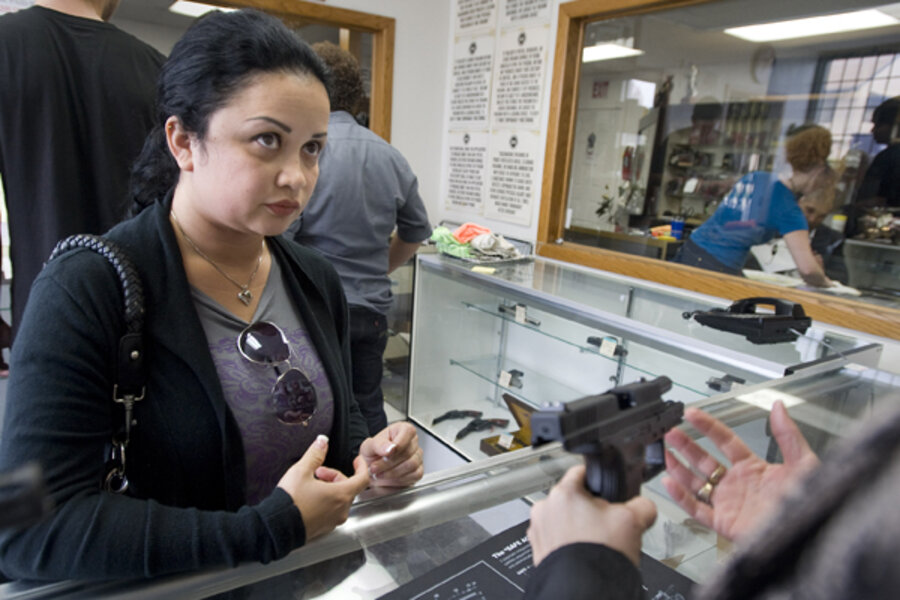A look at America's gun industry
Loading...
As the debate over gun control gains new urgency in the wake of the mass shooting in Newtown, Conn., the firearms industry in the United States is thriving. Gun sales are setting records, driven by fear, politics, and recreation. Here is a brief overview of the US gun industry.
Q: How big is the US firearms industry?
Its total economic impact on the United States this year is estimated at $31.8 billion, according to the National Shooting Sports Foundation. While that's less than 1 percent of the US gross domestic product, it's about what Americans spend on the arts in a year, and the equivalent of Nigeria's federal budget for 2013.
While tracking sales of firearms in the US is tricky, federal officials report that they were higher than ever in 2012. Through the end of November, the FBI had recorded 16.5 million background checks for gun purchases this year – the most since the FBI began tracking such data in 1998. The actual number of guns sold is higher, since registrants can buy multiple guns. Also, private sales and many gun-show sales do not require an FBI check. While no current figures are available, past estimates of private sales of firearms (no background check required) put the figure at 40 percent of all sales.
Q: What's driving the rise in gun sales in the US?
Two factors in recent history have tended to send gun sales soaring. Gun sales usually spike in the days after a mass shooting: Requests for background checks rose 41 percent in Colorado in the wake of the Aurora movie theater shooting in July, and similar spikes had followed Columbine in 1999 as well as the 2011 shooting in Tucson, Ariz., that wounded then-US Rep. Gabby Giffords. After the Newtown tragedy, gun sales have been setting new records in several states.
The second factor is politics. Sales spiked in anticipation of Barack Obama's election in 2008 and 2012, fueled by fears that new gun restrictions would follow.
Mr. Obama's presidency has been a boon for gunmakers, in fact. While he has enacted no new gun restrictions (though he is weighing them now), and has actually acted in support of expanded gun rights, industry analyst Jim Barrett called Obama "the best thing that ever happened to the firearms industry," in an Associated Press interview. According to an October analysis by AP, Ruger & Co. and Smith & Wesson, the two biggest gunmakers in the US, have seen their profits rise by 86 percent and 41 percent, respectively, since Obama took office.
Altogether, gunmakers manufactured about 5.5 million firearms in the US in 2010, a drop of less than 1 percent over 2009, according to the federal Bureau of Alcohol, Tobacco, Firearms, and Explosives. That is on the heels of a 29 percent rise in production in 2009 (mostly pistols), however.
Of that 2010 production, some 242,000 firearms were exported, while an additional 3.25 million were imported from other countries.
Q: How many guns do Americans own?
As of 2009, Americans owned an estimated 310 million firearms, according to the National Institute of Justice – roughly one for every person in the US. That represents a doubling of the number of guns owned per capita since 1968. America's domestic arsenal includes some 114 million handguns, 110 million rifles, and 82 million shotguns. Back in 2007, the US ranked No. 1 worldwide in gun ownership per capita, at 88.8 guns for every 100 people. Nations with the next-highest totals that year were Serbia (58.2 guns per 100 people) and Yemen (54.2).
Q: Who owns guns?
Gun registrations correspond loosely to population: The US state with the most registrations (as of March) was California, followed by Texas and Virginia. Rhode Island had the fewest registrations.
In a 2011 Gallup poll, 47 percent of Americans reported having at least one gun in their home. Of those, most (62 percent) said they had more than one. The most popular reasons for owning a gun: self-defense (67 percent), target shooting (66 percent), and hunting (62 percent).





